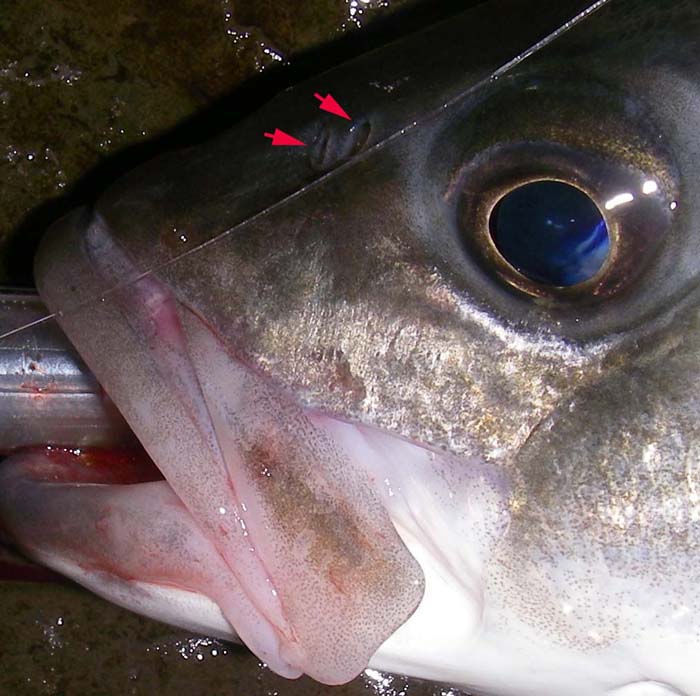 '
'Information Page.
MIKE'S ON HOLIDAY FOR A COUPLE OF WEEKS _ BACK IN AUGUST.
A whiff of success.
Pick up the next fish you catch and look it straight in the face before returning it to the sea (or popping it in the bag). On either side of your opponent’s snout you will notice a couple of little holes. Of course if your catch is a shark, dogfish or ray you will have to turn it upside down and look underneath its head to see these ‘nostrils’, but the principle is just the same.
Unlike us, fish have managed to separate the business of breathing from that of smelling things by separating the entrance and the exit to the nasal cavity. The design of these holes is such that, as the fish swims along, water flows in one and out of the other. In doing so it passes over a folded membrane plastered with “smell receivers.”
Before we delve any further into the fish’s nose it is worth thinking about a couple of things; firstly, because fish are bathed in water full of dissolved substances their senses of smell and taste are not so distinctly different as ours. Secondly, the sort of chemicals which we smell and those which readily evaporate and drift about in the air, but in the case of fish the important thing is that the substance should be soluble in water. In other words things which smell strong to us may not be noticeable to fish, while things which can be smelt by fish may not be apparent to humans.
We know rather little about which fish have the best sense of smell, but species like eels and dogfish, which are nocturnal and obviously find most of their food without the aid of sharp eyes, have large and much folded nasal organs. The same is true of salmon and their relatives which are known to find there way home largely by sniffing slight traces of chemicals in their home rivers. For anyone who doubts this ability it is probably worth quoting an example. Young salmon, just ready to leave for the sea, were placed in tanks, with minute traces of either morpholine or phenethyl alcohol added to the water. Eighteen months later small quantities of the chemicals were dripped into separate tributaries of the spawning river ninety five percent of the morpholine conditioned fish went in to the morpholine stream and ninety two percent of the phenethyl alcohol salmon also chose the correct channel. Impressive, eh!
What about finding food and feeding (matters much nearer to an anglers heart)? Manufacturers of bait additives and enhancers would have us believe that a few drops of the latest chemical cocktail will enhance our catches. For certain, if enough people dip their baits in anything then sooner or later they will make decent catches - thus are myths and legends born. Of course if you use a fish bait and dip it in “crab essence” you may attract a few wrasse or smoothhounds which would not have touched the untreated bait. Similarly, a dose of pilchard oil or “fishy flavour” may tempt a fish-eater to take a worm or squid “by mistake”.
Quite apart from the many species of fish which rely mainly on their sense of smell to find prey (often those which feed in dark or muddy waters) even sight hunters like tunny or mackerel are capable of distinguishing the scents of different types of living prey. They may use faint scent trails to set them on the track of potential victims, and even adopt different types of feeding behaviour to differently smelling prey.
In addition to the matter of food location, scents and tastes often perform another function. Just as the smell of freshly baked bread, or the aroma of meat and two veg, can make our mouths water, so our fishy cousins can be turned on by the right chemicals. Feeding stimulants for fish always have certain chemical characteristics. Firstly they are small molecules; secondly they are not very smelly to us; thirdly they contain nitrogen; and lastly they can behave both as acids and alkalis.
Different species of fish probably respond to different stimulants. The scientific evidence suggests that single chemicals are not much use as turn-ons, but the various species each react to special, fingerprint-like cocktails of substances. The best way to be sure of having exactly the right combination is to use known, fresh natural foods.
The sense of smell is important in controlling the homing and feeding behaviour of fishes, but it does have other vital functions. Many male fish react to the smell of females. In fact males which have had there noses blocked may be totally oblivious to the blandishments of even the prettiest members of the opposite sex.
Even more remarkable are the “alarm substances” produced by some species of fish. The best way to imagine these substances is as the chemical equivalent of the white scuts of rabbits or the white behinds of deer. When a fish takes fright or is attacked all its shoal mates react in the appropriate way to the chemicals it releases. Only a few types of fish are known to produce alarm substances, but it is quite possible that pricking or losing a fish can reduce your chance of further success.
If you have any comments or questions about fish, methods, tactics or 'what have you.'get in touch with me by sending an E-MAIL to - docladle@hotmail.com
Bass snout.
 '
'Pike snout.
 '
'